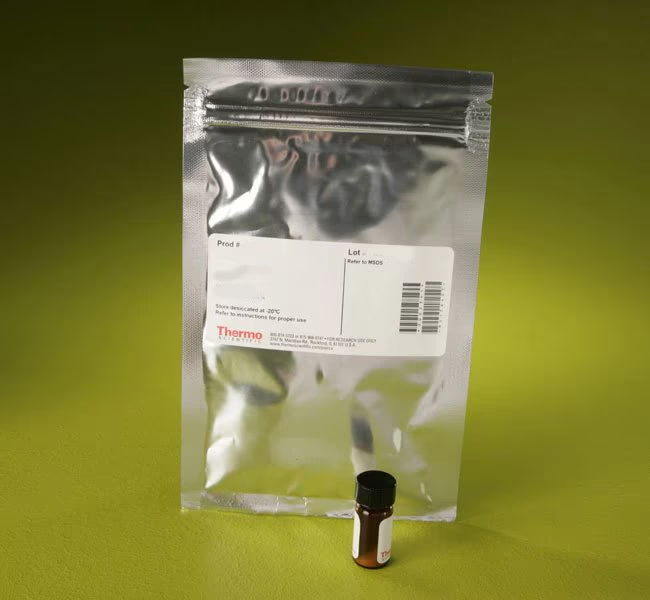
Thermo Scientific Pierce MM(PEG)12 is a methyl-terminated, polyethylene glycol compound (12 PEG units) activated with a maleimide group for covalent pegylation of sulfhydryls on proteins (e.g., cysteines) or assay surfaces.
Features of MM(PEG)12:
• Maleimide-activated for efficient PEGylation of sulfhydryl groups at pH 6.5-7.5; reaction of maleimide group results in formation of stable, irreversible thioether bonds
• Fully characterized PEGylation reagents with defined PEG chain lengths; molecules of discrete molecular weight for consistency of performance in protein-modification applications
• Provided with 12 ethylene glycol units, enabling modification procedures to be optimized for a specific application while retaining all the benefits associated with protein PEGylation
• PEG spacer provides unique advantages, including increased stability, reduced tendency toward aggregation and reduced immunogenicity
• Easy-to-follow instructions increase the likelihood of a successful outcome
PEGylation Applications:
• PEGylate amine surfaces
• Add inert mass to proteins, immunogens, drug compounds and probes
• Improve solubility (decrease aggregation) of proteins or peptides without affecting function
• Protect proteins from proteolysis
Why PEGylate a protein or peptide?
PEG-containing reagents have been used to modify proteins to provide specific advantages. Protein PEGylation can improve the stability of the modified protein, protect it from proteolytic digestion, increase its half life in biological applications, mask it from causing an immunogenic response, decrease its antigenicity or potential toxicity, improve its solubility, diminish the potential for aggregation, and minimize interference for both in vitro and in vivo applications. Polyethylene glycol, also called polyethylene oxide (PEO), has these effects because it is nontoxic, nonimmunogenic, hydrophilic, water soluble and highly flexible.
Advantages of Discrete-length mPEG-NHS Ester Compounds:
These reagents are specially synthesized as homogeneous compounds of discrete chain length and defined molecular weight. As such, they enable precise control and optimization of surface protein modification experiments. By contrast, typical preparations of PEG compounds are heterogeneous mixtures composed of multiple chain lengths and a range of molecular weights.
Related Products
MM(PEG)24 Methyl-PEG-Maleimide Reagent
| Code | Description |
|---|---|
| 22711 | Catalog Number: 22711 |

